When to Replace Your Roof - Critical Warning Signs & Expert Guidance
Jump to Section
Navigate directly to the information you need
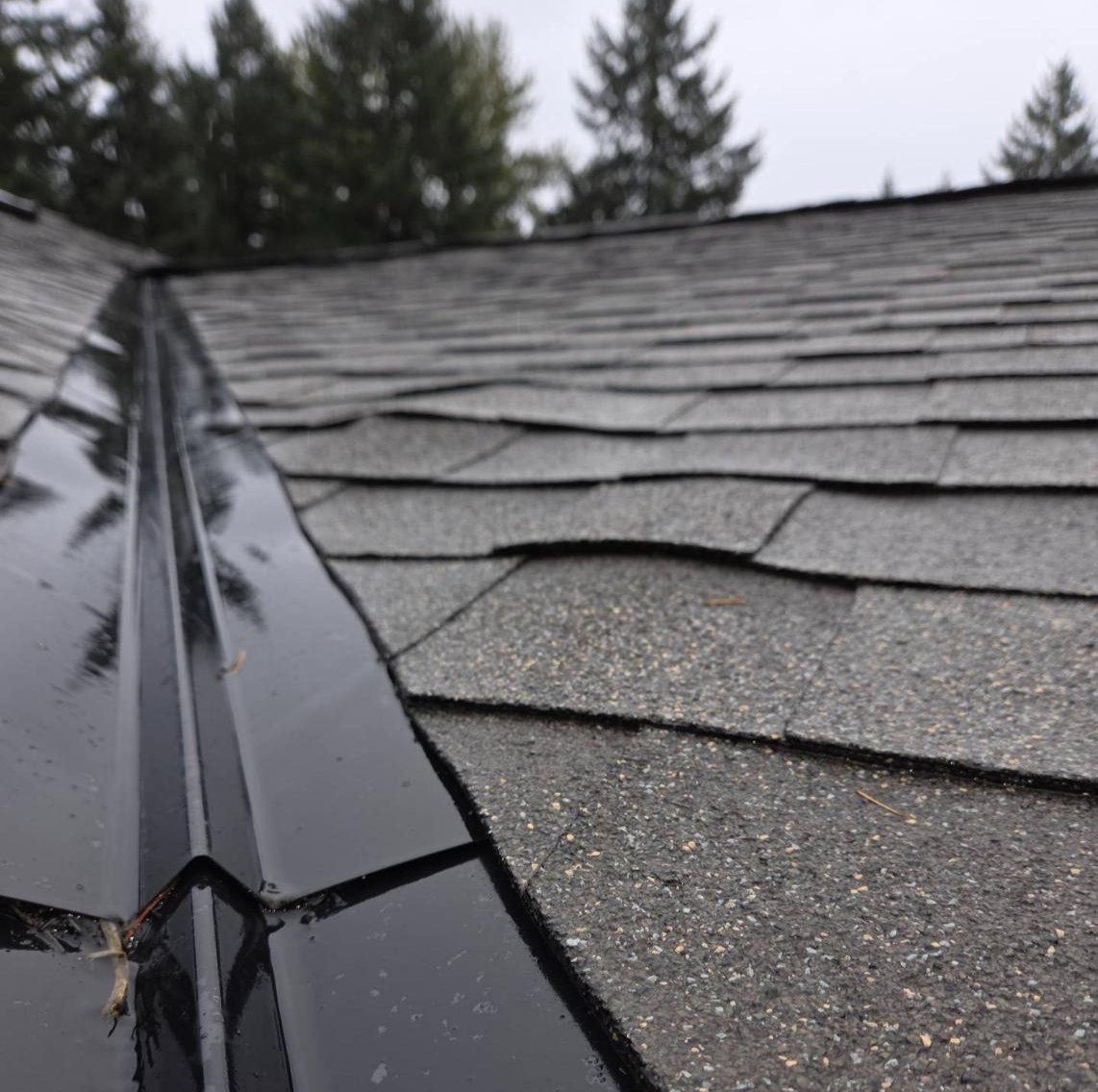 Knowing when to replace your roof is one of the most important decisions you'll make as a homeowner. Your roof protects everything inside your home, from your family to your belongings, and waiting too long to replace it can lead to expensive water damage, structural issues, and even health hazards from mold growth. On the other hand, replacing a roof prematurely means spending thousands of dollars unnecessarily. In Vancouver's rainy climate, where roofs face constant moisture, heavy storms, and moss growth, understanding the right timing for roof replacement becomes even more critical. This comprehensive guide will walk you through the 8 critical warning signs that indicate roof replacement is necessary, help you understand typical roof lifespan expectations, and provide a framework for deciding between repair and replacement.
Knowing when to replace your roof is one of the most important decisions you'll make as a homeowner. Your roof protects everything inside your home, from your family to your belongings, and waiting too long to replace it can lead to expensive water damage, structural issues, and even health hazards from mold growth. On the other hand, replacing a roof prematurely means spending thousands of dollars unnecessarily. In Vancouver's rainy climate, where roofs face constant moisture, heavy storms, and moss growth, understanding the right timing for roof replacement becomes even more critical. This comprehensive guide will walk you through the 8 critical warning signs that indicate roof replacement is necessary, help you understand typical roof lifespan expectations, and provide a framework for deciding between repair and replacement.
Most asphalt shingle roofs last between 20 to 30 years depending on material quality, installation workmanship, and climate conditions. However, age isn't the only factor to consider when determining if it's time for roof replacement. Visible damage, performance issues, and the extent of needed repairs all play crucial roles in this decision. Whether you're seeing curled shingles, noticing water stains on your ceiling, or simply wondering if your 20-year-old roof is nearing the end of its life, this guide provides the specific, actionable information you need. We'll cover what to look for during a roof inspection, how Vancouver's climate affects roof lifespan, and what to expect during the roof replacement process.
8 Critical Signs It's Time to Replace Your Roof
While professional roof inspection provides the most accurate assessment, homeowners can identify several warning signs that indicate roof replacement may be necessary. Here are the 8 most critical indicators that your roof has reached the end of its serviceable life:
Significant Granule Loss
 Asphalt shingles are coated with protective granules that shield the underlying material from UV rays and weather damage. When shingles age, these granules loosen and wash away, exposing the asphalt layer beneath. Check your gutters after rain - if you're finding large amounts of granules (they look like coarse sand or grit), your shingles are deteriorating. Widespread granule loss across your roof indicates the shingles have reached the end of their protective lifespan and can no longer effectively protect your home from the elements. This is one of the clearest signs that it's time to consider roof replacement rather than attempting patchwork repairs.
Asphalt shingles are coated with protective granules that shield the underlying material from UV rays and weather damage. When shingles age, these granules loosen and wash away, exposing the asphalt layer beneath. Check your gutters after rain - if you're finding large amounts of granules (they look like coarse sand or grit), your shingles are deteriorating. Widespread granule loss across your roof indicates the shingles have reached the end of their protective lifespan and can no longer effectively protect your home from the elements. This is one of the clearest signs that it's time to consider roof replacement rather than attempting patchwork repairs.
Curling, Cupping, or Warping Shingles
 Shingles that curl at the edges (curling), cup in the middle (cupping), or appear wavy and distorted (warping) are clear indicators of aging and weathering. This happens when shingles lose their flexibility due to prolonged exposure to heat, moisture cycles, and UV radiation. Curled or cupped shingles can no longer seal properly against wind and rain, allowing water infiltration. When you see this condition affecting more than 25% of your roof, replacement is typically more cost-effective than attempting widespread repairs. This deterioration is particularly common in Vancouver's climate where frequent wet-dry cycles accelerate the aging process of asphalt shingle roofing materials.
Shingles that curl at the edges (curling), cup in the middle (cupping), or appear wavy and distorted (warping) are clear indicators of aging and weathering. This happens when shingles lose their flexibility due to prolonged exposure to heat, moisture cycles, and UV radiation. Curled or cupped shingles can no longer seal properly against wind and rain, allowing water infiltration. When you see this condition affecting more than 25% of your roof, replacement is typically more cost-effective than attempting widespread repairs. This deterioration is particularly common in Vancouver's climate where frequent wet-dry cycles accelerate the aging process of asphalt shingle roofing materials.
Missing or Damaged Shingles
 A few missing shingles after a windstorm can usually be repaired without issue. However, if you're regularly finding missing, cracked, or broken shingles across multiple areas of your roof, this indicates systemic failure. Shingles become brittle with age and lose their ability to withstand normal weather conditions. When shingle damage is widespread rather than isolated, the entire roof system has likely deteriorated to the point where individual repairs are no longer practical or economical. This is a key indicator that you should seriously consider full roof replacement to avoid more extensive damage down the road.
A few missing shingles after a windstorm can usually be repaired without issue. However, if you're regularly finding missing, cracked, or broken shingles across multiple areas of your roof, this indicates systemic failure. Shingles become brittle with age and lose their ability to withstand normal weather conditions. When shingle damage is widespread rather than isolated, the entire roof system has likely deteriorated to the point where individual repairs are no longer practical or economical. This is a key indicator that you should seriously consider full roof replacement to avoid more extensive damage down the road.
Extensive Moss or Algae Growth
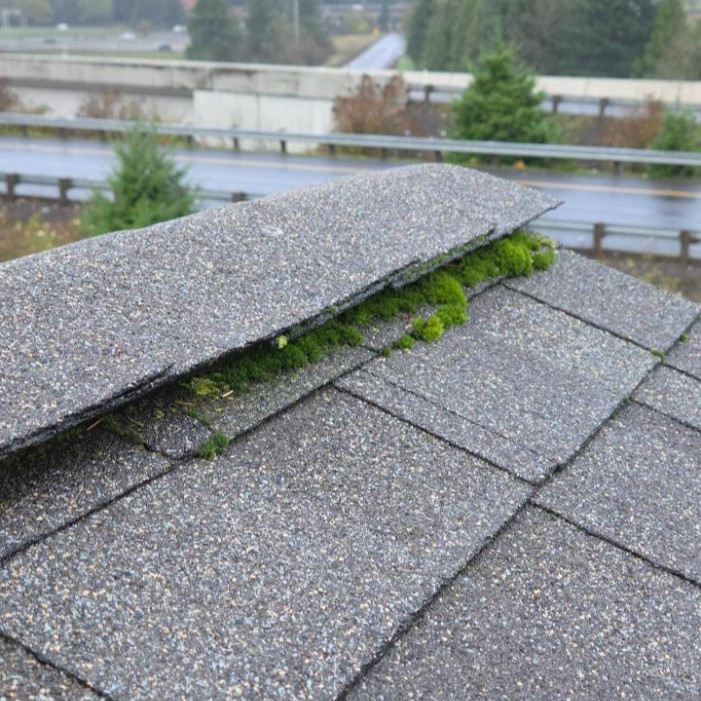 In Vancouver's damp climate, moss and algae growth on roofs is extremely common, especially on north-facing slopes that receive less direct sunlight. While light moss growth can sometimes be cleaned, extensive moss that has established deep roots poses a serious problem. Moss roots burrow under shingles, lifting them and allowing water to penetrate underneath. This moisture trapped under shingles accelerates rot in the underlying roof decking. If moss covers more than 30% of your roof surface or has been growing for several years, the damage may be extensive enough to warrant full roof replacement rather than cleaning and repair.
In Vancouver's damp climate, moss and algae growth on roofs is extremely common, especially on north-facing slopes that receive less direct sunlight. While light moss growth can sometimes be cleaned, extensive moss that has established deep roots poses a serious problem. Moss roots burrow under shingles, lifting them and allowing water to penetrate underneath. This moisture trapped under shingles accelerates rot in the underlying roof decking. If moss covers more than 30% of your roof surface or has been growing for several years, the damage may be extensive enough to warrant full roof replacement rather than cleaning and repair.
Daylight Through Roof Boards or Water Stains
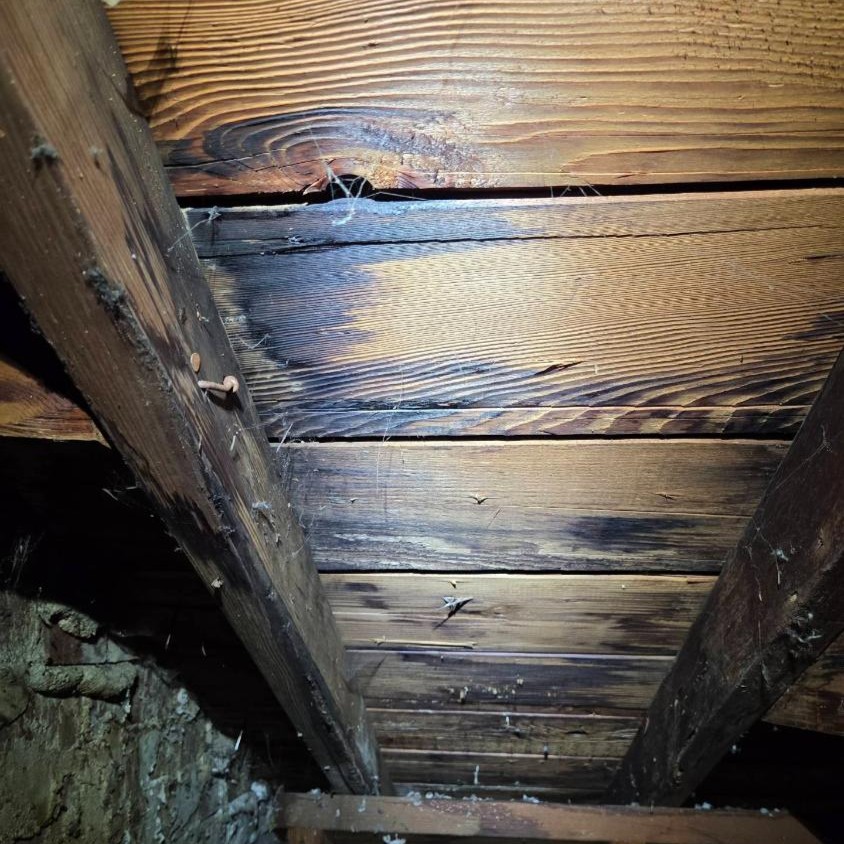 Go into your attic on a sunny day and look up at the underside of your roof deck. If you can see daylight coming through cracks, gaps, or holes in the roof boards, you have a serious problem that requires immediate attention. Where light gets through, so does water, cold air, and moisture. Similarly, water stains on your ceiling or walls, especially after rain, are clear indicators that your roof is no longer effectively keeping water out. Widespread daylight visibility or multiple leaks in different areas indicate the structural integrity of your roof system is compromised, and full replacement is necessary to protect your home from continued water damage.
Go into your attic on a sunny day and look up at the underside of your roof deck. If you can see daylight coming through cracks, gaps, or holes in the roof boards, you have a serious problem that requires immediate attention. Where light gets through, so does water, cold air, and moisture. Similarly, water stains on your ceiling or walls, especially after rain, are clear indicators that your roof is no longer effectively keeping water out. Widespread daylight visibility or multiple leaks in different areas indicate the structural integrity of your roof system is compromised, and full replacement is necessary to protect your home from continued water damage.
Sagging Roof Deck or Soft Spots
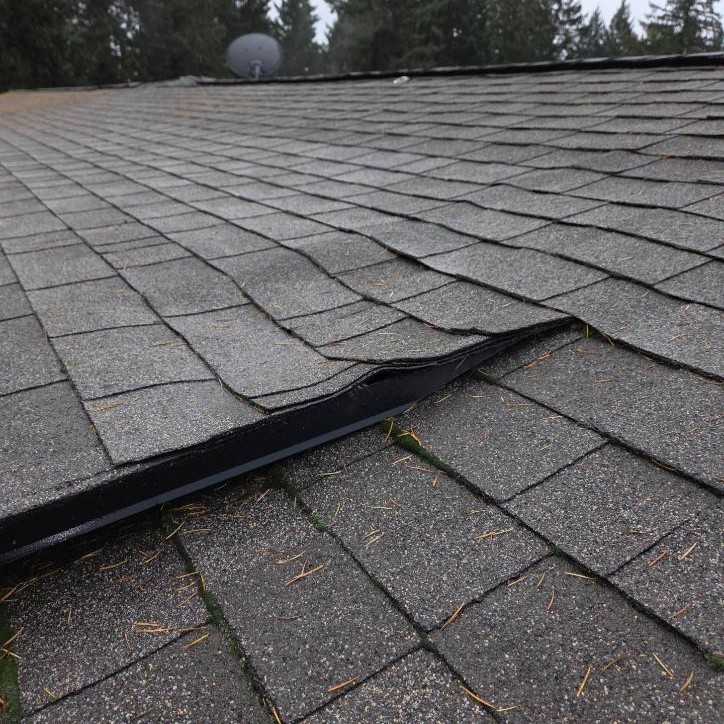 A sagging or dipping roofline is one of the most serious warning signs when determining when to replace your roof. This indicates structural problems with the roof deck, often caused by prolonged water exposure that has rotted the underlying plywood or OSB sheathing. Stand back from your house and look at the roofline from different angles. A healthy roof should have straight, clean lines. If you notice any sagging, dipping, or drooping areas, this is a critical issue requiring immediate professional evaluation. Sagging roof decks pose safety risks and always require replacement of both the decking and the shingles above it.
A sagging or dipping roofline is one of the most serious warning signs when determining when to replace your roof. This indicates structural problems with the roof deck, often caused by prolonged water exposure that has rotted the underlying plywood or OSB sheathing. Stand back from your house and look at the roofline from different angles. A healthy roof should have straight, clean lines. If you notice any sagging, dipping, or drooping areas, this is a critical issue requiring immediate professional evaluation. Sagging roof decks pose safety risks and always require replacement of both the decking and the shingles above it.
Active Leaks After Heavy Rain
 While a single isolated leak might be repairable, multiple leaks in different areas or recurring leaks in the same spot despite previous repairs suggest systemic roof failure. Pay attention to brown or yellow staining on ceilings, peeling paint near the roofline, or musty odors in your attic. When leaks are widespread or persistent, attempting repeated repairs often costs more over time than replacing the entire roof system. Additionally, prolonged water intrusion can lead to mold growth, insulation damage, and structural wood rot that extends far beyond the original leak point.
While a single isolated leak might be repairable, multiple leaks in different areas or recurring leaks in the same spot despite previous repairs suggest systemic roof failure. Pay attention to brown or yellow staining on ceilings, peeling paint near the roofline, or musty odors in your attic. When leaks are widespread or persistent, attempting repeated repairs often costs more over time than replacing the entire roof system. Additionally, prolonged water intrusion can lead to mold growth, insulation damage, and structural wood rot that extends far beyond the original leak point.
Popped or Exposed Nails
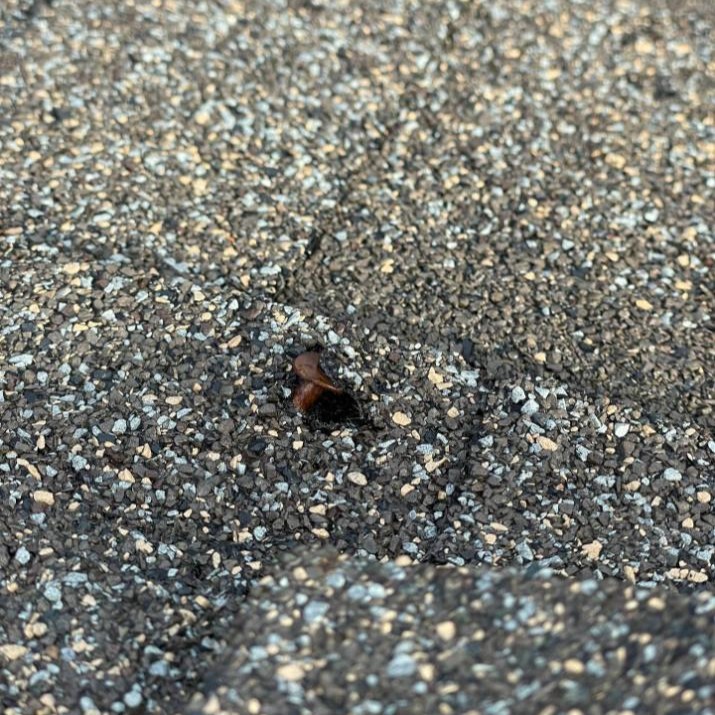 Roofing nails that have worked their way up through shingles (called "nail pops") create puncture holes that allow water to enter. While a few popped nails here and there can be repaired, widespread nail popping across your roof indicates the roof deck is expanding and contracting excessively - often due to moisture problems - or that the original installation used improper nailing techniques. Extensive nail pops compromise the structural attachment of shingles to your roof deck and create numerous entry points for water.
Roofing nails that have worked their way up through shingles (called "nail pops") create puncture holes that allow water to enter. While a few popped nails here and there can be repaired, widespread nail popping across your roof indicates the roof deck is expanding and contracting excessively - often due to moisture problems - or that the original installation used improper nailing techniques. Extensive nail pops compromise the structural attachment of shingles to your roof deck and create numerous entry points for water.
Important Note
If you're seeing multiple warning signs from this list, it's time to schedule a professional roof inspection. Our team provides free, no-obligation roof assessments to Vancouver homeowners, giving you an honest evaluation of your roof's condition and remaining lifespan.
Roof Age: When Does a Roof Typically Need Replacement?
Understanding typical roof lifespan helps you anticipate when to replace your roof before major problems develop. Different roofing materials have different expected lifespans, and local climate conditions significantly impact how long a roof will last. In Vancouver's wet climate with heavy rainfall and frequent moss growth, roofs often reach the end of their serviceable life on the earlier end of these ranges.
Asphalt Shingle Roofs
3-Tab Shingles: 15-20 years
The most economical option, but shortest lifespan. Most 3-tab roofs in Vancouver need replacement by year 18-20 due to climate stress.
Architectural Shingles: 25-30 years
Thicker, more durable than 3-tab. Quality architectural shingles can reach 30 years with proper maintenance and favorable conditions.
Premium/Designer Shingles: 30-50 years
High-end shingles like those from Malarkey's premium line offer extended warranties and superior durability.
Age-Based Action Plan
15-18 years: Monitor Closely
Schedule annual inspections and budget for replacement within 2-4 years
20-23 years: Plan Replacement
Increase inspection frequency to twice yearly; begin getting quotes and planning the project
25+ years: Replace Proactively
Consider replacement before failure occurs, even without visible problems
Factors That Shorten Roof Lifespan
Even with quality materials, several factors can significantly reduce your roof's lifespan, particularly in the Pacific Northwest climate. Understanding these factors helps you anticipate when to replace your roof earlier than the manufacturer's stated warranty period.
Climate Stress
Vancouver's frequent wet-dry cycles accelerate shingle deterioration and promote moss growth, reducing expected lifespan by 2-5 years.
Poor Ventilation
Inadequate attic ventilation traps heat and moisture, causing shingles to age prematurely from the underside.
Tree Coverage
Roofs under heavy tree coverage stay damp longer, promoting moss and algae growth that accelerates wear.
The True Cost of Delaying Roof Replacement
When you've identified warning signs that indicate it's time to replace your roof, postponing the project might seem like a way to save money in the short term. However, delaying necessary roof replacement typically costs homeowners significantly more in the long run through compounding damage and emergency repairs.
Interior Water Damage
A failing roof allows water into your attic, walls, and ceilings. The cost to repair water damage often exceeds $5,000-$15,000.
Typical cost: $5,000-$15,000+
Structural Wood Rot
Prolonged water intrusion rots roof decking, rafters, and structural framing, significantly increasing replacement costs.
Additional cost: $2,000-$8,000
Mold Remediation
Moisture from a failing roof creates ideal conditions for mold growth in attics and walls requiring professional remediation.
Typical cost: $2,000-$10,000
Emergency Repairs
When a deteriorating roof finally fails completely during a storm, emergency repair rates are typically 50-100% higher.
Premium cost: 50-100% markup
Cost Comparison Example
Proactive replacement today: $12,000
Delaying 2 years with damage:
- • Water damage repairs: $6,500
- • Rotted deck replacement: $3,200
- • Damaged insulation: $1,800
- • Roof replacement: $12,000
Total: $23,500 (96% more expensive)
Roof Repair vs. Replacement: How to Decide
One of the most challenging decisions homeowners face is determining when to replace your roof versus when repair is sufficient. Here's a practical framework to help you make this decision based on the extent and nature of your roof problems.
Repair Makes Sense When:
- Damage is localized to one area (less than 20-25% of roof)
- Your roof is less than 15 years old
- Recent storm damage to otherwise healthy roof
- Repair cost is less than 20-25% of replacement
Replacement Makes Sense When:
- Damage covers more than 25-30% of roof
- Your roof is 20+ years old
- Multiple leaks in different areas
- Widespread shingle deterioration
Our Honest Assessment Promise
At Gold Shield Exteriors, we provide honest evaluations of whether repair or replacement makes the most sense for your specific situation. We'll never recommend replacement if repair is appropriate, and we'll explain our reasoning with photos and cost comparisons.
What to Expect During a Roof Replacement
Understanding what happens during roof replacement helps you prepare appropriately. Here's what most Vancouver homeowners can expect during the roof replacement process:
Pre-Project Preparation
Your contractor delivers dumpster, sets up equipment, and installs protective materials. You should move vehicles, cover attic items, and remove wall hangings.
Old Roof Tear-Off
The crew removes all existing shingles down to the roof deck. This is the loudest phase - expect significant noise for 2-4 hours.
Deck Inspection & Repair
Once the old roof is removed, the contractor inspects all decking for damage. Any rotted or compromised boards are replaced.
New Installation
Installation of underlayment, ice shield, drip edge, and new shingles. All penetrations receive new flashing and proper sealing.
Cleanup & Inspection
Thorough cleanup using magnetic rollers to collect nails. Final walkthrough inspection and warranty paperwork provided.
Typical Timeline
Simple residential roofs (1,500-2,000 sq ft): 2-3 days. Complex or large roofs: 4-5 days. In Vancouver's climate, allow flexibility for rain delays.
Frequently Asked Questions About Roof Replacement Timing
How do I know if my roof needs to be replaced or just repaired?
Consider replacement if your roof is 20+ years old, has damage covering more than 25% of its surface, shows multiple leaks, or exhibits widespread shingle deterioration. A professional roof inspection provides the most accurate assessment.
What is the typical lifespan of an asphalt shingle roof in Vancouver?
In Vancouver's wet climate, 3-tab shingles typically last 15-20 years, while architectural shingles last 25-30 years. Vancouver's heavy rainfall and moss growth can reduce these lifespans by 2-5 years.
Can I wait another year to replace my roof if I see warning signs?
If you have active leaks, sagging areas, or widespread shingle damage, delaying replacement risks water damage that will cost far more to repair than proactive roof replacement.
How much does roof replacement typically cost in Vancouver, WA?
For a typical 1,500-2,000 square foot residential roof, expect to pay $8,000-$15,000 for quality architectural shingle replacement. Costs increase for larger roofs or if significant deck repair is needed.
What time of year is best for roof replacement in Vancouver?
Late spring through early fall (May-October) offers the most reliable weather windows. Summer months provide the driest conditions, though contractors are busiest then.
Will my homeowners insurance cover roof replacement?
Insurance typically covers roof replacement if damage resulted from storm damage, falling trees, or fire. Normal wear and tear from aging is not covered.
Making the Right Decision for Your Vancouver Home
Knowing when to replace your roof is a critical decision that balances immediate costs against long-term home protection. By watching for the 8 warning signs covered in this guide and understanding typical roof lifespan expectations, you can identify when your roof has reached the end of its effective service life. Remember that age alone, particularly once asphalt shingle roofs reach 20-25 years, is often sufficient reason to plan for replacement even without obvious damage.
If you're experiencing any of the warning signs discussed, or your roof is approaching the typical lifespan for its material type, schedule a professional roof inspection to assess its condition objectively. At Gold Shield Exteriors, we provide honest evaluations and clear guidance on whether repair or replacement makes the most sense for your specific situation.
Get Your Free Roof Assessment Today
Ready to find out if it's time to replace your roof? We provide honest assessments, detailed inspections, and expert guidance backed by 25+ years of experience.
Not Sure If It's Time to Replace Your Roof?
Get a free, honest assessment from Vancouver's trusted roofing experts. We'll inspect your roof, show you exactly what we find, and provide clear guidance on repair vs. replacement.
Licensed • Insured • Serving Clark County • 50-Year Warranty Available
